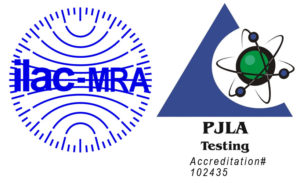
Universal Controller
Dynatek’s new Universal Controller (UC; Fig. 1) is a powerful unit that has been redesigned to control and monitor Dynatek’s six position M6 Heart Valve Tester (M6).
Although the monitoring and control aspects of the UC are impressive, perhaps of equal or greater importance is the time saved setting up or monitoring the “95/5” requirements for the closing pressure of each valve. The UC can accept 12 pressure transducers, two for every position in the M6. When using all 12 transducers, each valve can be tested simply by choosing each sequentially – no need to change the position of the transducer after each valve is checked.
This saves hours of labor during the initial setup. Simply choose the first valve position, set the M6 swash plate, throttle valve and systemic pressure. Start the tester up and take and analyze the data for desired peak pressure and the 95/5 requirement. Re-tune to obtain desired results. Then query all remaining valves sequentially with the touch of a button. If any valves are out of specification, retune and retest. The process usually takes less than an hour. The same goes for intermediate pressure checks. These rechecks take about 20 minutes if nothing has changed. Over the course of a 400 million cycle test, you can save many hours of labor per test.
In addition, the UC allows all 12 transducers to be calibrated in one step, thus saving a tremendous amount of time at the start of each test.
Simplified HMI
The UC has a simplified Human-Machine Interface (HMI), with only a single user-operated button on the face of the controller: the Emergency Stop. In contrast, older controllers had additional switches on the front and back panels. The simpler control interface of the UC communicates the instrument and process status to the operator via colored signal LEDs (see UC specifications below).
Advanced UC Software Capabilities Data Integrity and Security
The UC creates a comprehensive data file that logs all test parameters and alarm events in TDMS format at user-configurable intervals of one or five minutes for the entire duration of the test. 21 CFR Part 11 lists a number of requirements for Electronic Records1 and the UC offers the following benefits for users:
• An electronic record of the complete test in human readable form for inspection, review and copying by regulatory agencies.
• Validation of the system to ensure accuracy, reliability, and consistent intended performance.
• System access limited to authorized individuals.
• Protection and encryption of records to enable their accurate and ready retrieval.
• An audit trail in the form of a secure, computer-generated time-stamped electronic record that allows the reconstruction of the events in the test.
• Provides verification of test parameters.
• Allows annotation and explanation by the operator of any anomalous event.
The UC outputs the data log file to the PC at pre-defined periods, in TDMS format which are then zipped in an archive with 256-bit encryption.
Sophisticated Alarm Processing
The UC allows you to add alarms to parameters of your choice, to either allow the user to examine specific performance criteria in the test or shut down the test altogether. These alarms are user-configurable and are triggered when the value of the parameter being measured exceeds a preset high or low value.
User-defined alarms can be invoked in addition to existing alarms on standard parameters, or may be added to any parameter that the UC monitors.
All user-configurable alarms can be configured with any appropriate alarm level and action. Alarms can be used with Warning or Error Limits to warn of the movement of any parameter towards unfavorable process conditions, or as a Critical Limit to stop the test in the case of a parameter exceeding an unacceptable operating limit (Fig. 2).
Alarms on the UC can be used in a wide variety of process applications to provide:
• An independent emergency shutdown to avert undesirable system conditions.
• Ample warning and response time to the operator to intervene and avoid a system shutdown.
• Alarm trips that are user-defined.
• A user-defined ‘dwell time,’ where an alarm is triggered only after an alarm state has lasted longer than the dwell time, e.g., preventing spikes caused by unstable power supply from shutting down the unit.
The user can annotate any event or alarm condition that has been logged, and all data and annotations are date- and time-stamped in the log file in chronological fashion.
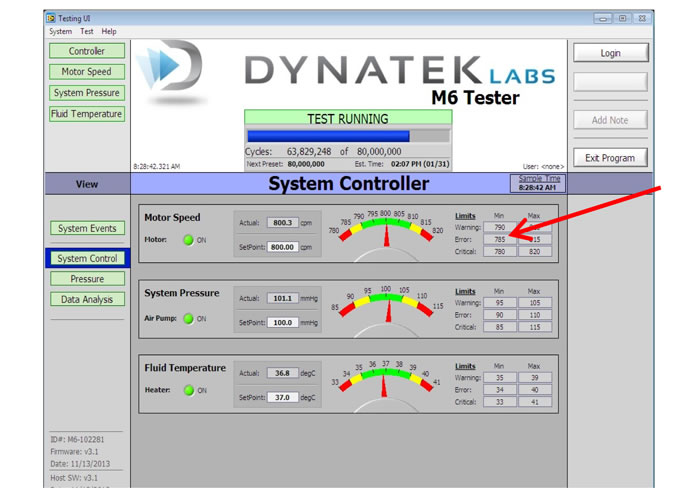
M6 Calibration
By eliminating hardware-based calibration modules, the UC software supports accurate calibration of inflow and outflow pressure transducers on the M6, saving time and shortening the start-up phase of the heart valve tester.
M6 System Control
The UC’s advanced controller software allows the user to monitor and control critical controller functions through the System Controller tab (Fig. 3). The System Controller view lets you choose System Events, System Control, Pressure and Data Analysis options in a well-laid out screen, allowing ease of navigation and use.

Differential Pressure
Pressure transducers can be installed in M6 test sections holding sample artificial heart valves to let you monitor inflow and outflow pressure regimes that the valve is undergoing. The UC software allows you to capture these pressure data and generate a differential pressure waveform for any valve being tested, simply by pressing the ‘Start Capture’ button (Fig.4).
Data Analysis
Proprietary technology in the UC’s software allows powerful data analysis on the M6 (Fig. 4):
Start Capture and Open/Close data– These controls allow you to capture new data while testing or open/close existing pressure waveform capture files to analyze inflow, outflow and differential pressures that the test valve is undergoing.
Graphs– This function allows you to plot a graph of inflow, outflow and/or differential pressure.
Comments field– This function allows you to type comments in the field and associate it with the data file when it is saved.
Target Closing Pressure– This function allows you to select a target closing pressure on the fly. Each time a new closing pressure is specified, the analysis is automatically rerun.
Analysis Results– Statistical analysis of the data relating to differential pressure is displayed onscreen (Fig. 4).
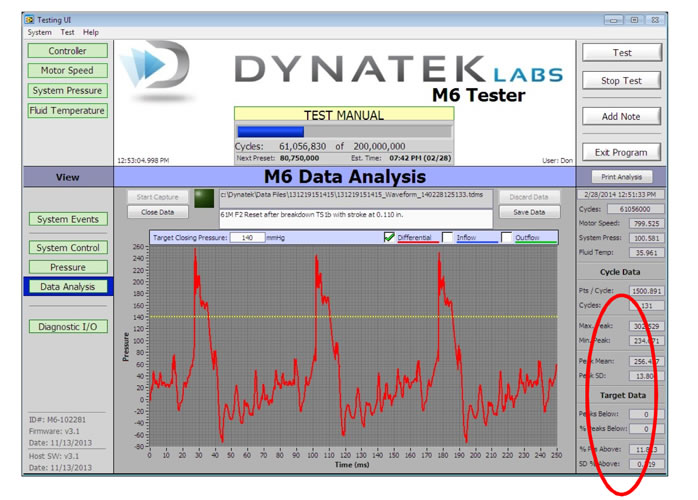
M6 Target Closing Pressure Verification
ISO standards2 mandate verification that targeted pressures across the closed valve were attained for at least 5% of each cycle during at least 95% of the test cycles. The UC has a powerful embedded algorithm that allows you to not only verify if pressures were following the 95/5 requirement or not, but also features the ability to drill down to a specific cycle in the waveform capture and verify the individual pressure profile of that cycle. The UC was designed from the ground up to not only run the machine it interfaces with, but also proves compliance of the test protocol with ISO/AAMI regulations.
Soft Start
With the M6 Heart Valve Tester, the UC ensures that every time the tester is started up when a test is in progress, the tester’s speed always starts from zero. This ensures that regardless of the speed that the previous run was terminated at, the startup speed is always zero (‘soft start’) and the UC slowly ramps up speed to the set speed for the test. The soft start feature ensures that forces on the valves being tested are not suddenly applied, preventing a possible tear or rupture of the valve material, regardless of the number of times the test is started up.
Oversampling
The UC sampling rate is software-based and user-configurable and can sample the pressure channels up to 20,000 samples/sec for the waveform capture. The UC typically oversamples the inputs at a minimum of 10x higher than the operating speed but usually the sampling rate is ~100x the operating speed. This is particularly useful in order to define transient pressure spikes.
Test Recall
The UC software has a Test Recall feature in the event that a test is prematurely aborted – either by user command or power loss/emergency stop. To access this feature, choose the “Test” pull-down menu at the top of the screen and select “Recall Test” to display the test parameters of the most recent test.
The Test Recall feature does not allow the user to edit any test parameters except cycle count presets, as the software is recalling the exact configuration of the test the user intends to recall. The UC software is so easy to use that you can resume the test from the point at which it stopped simply by selecting “Start Test.”
Key M6 Control Software Functions
The UC Control Software uses proprietary algorithms to offer the following key M6 functions, in addition to those listed above:
• Current cycle number at time of capture
• Motor speed at time of capture
• Date/time of capture
• Number of data points per cycle
• Number of cycles captured
• Highest peak in data set captured
• Lowest peak in data set captured
• Mean of peaks
• Standard deviation of peaks
• Number of peaks below target pressure
• Percent of peaks below target
• Average percent of data points in a cycle above target pressure
• Standard deviation of percent data points in a cycle above target pressure
• Take data
• Recall data
• Export/print data
• Nine modes of operation, including Lockout, Idle, Test, Suspend, Run and Abort
Key UC Hardware Features
At the heart of the UC is the powerful, high speed National Instruments 400 MHz sbRIO- 9632 board, with a Real-Time Operating System (RTOS) and a 2Mgate Field Programmable Gate Array (FPGA; Fig.5). The RTOS allows the UC to handle data coming in at high speed, without buffering delays. The FPGA is a dedicated piece of hardware that does not depend on the operating system to function. Thus, different functions can run independently and not have to compete for the same processing resources, creating a reliable, robust, high-performance controller that can handle high speeds and high volumes of real time data. For hardware specifications, see below and Fig. 6.
References
1. 21 CFR Part 11, Subpart B, 11.10. Controls for closed systems
2. ISO/AAMI 5840:2013. Cardiovascular Implants – Parts 1,2 and 3: Heart valve substitutes
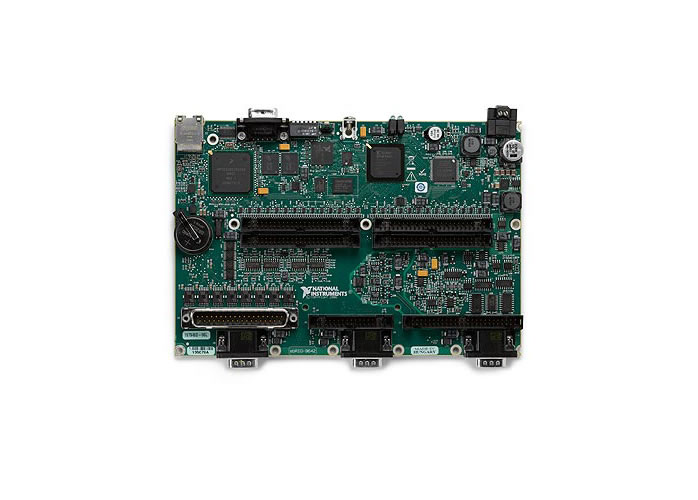
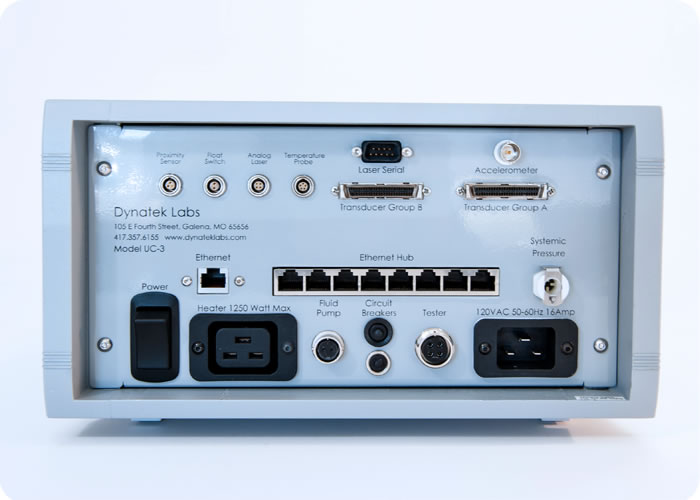
Universal Controller Hardware Specifications
|
Description
|
Specifications
|
|---|---|
|
Proximity Sensor
3-pin input
|
Proximity sensor to monitor rpm of motor with feedback loop to controller
|
|
Float Switch
2-pin input
|
Float switch to monitor fluid volume in capacitance tank
|
|
Analog Laser
4-pin I/O
|
Analog laser input/output for laser controller; not applicable to M6 |
|
Temperature Probe 5-pin input |
Temperature probe used to monitor temperature of test fluid |
|
Laser Serial I/O
|
9-pin RS232 Serial Bus for sending and receiving information to/from laser micrometer. Not applicable to M6 |
| Accelerometer BNC port | Not applicable to M6 |
| Transducer Group A & B 50-pin I/O | Two 50-pin connectors for mating with up to 12 transducers on upgraded M6 |
| Ethernet port | Standard Ethernet port connects UC to computer |
| Ethernet hub | Standard eight-port Ethernet hub |
| Female connector | Receives 1/8” hose barb coupling insert for systemic pressure tube |
| Power switch | Turns power on or off to the UC |
| Heater output | Drives heater to maintain test fluid temperature |
| Fluid Pump J1 connector | Not applicable to M6 |
| Tester J8 connector | Drives motor |
| 16 Amp socket | Main 120 VAC 50-60 Hz power input |
| Power light | Power light is green when unit is on and dark when the unit is off |
| Status light | Status light is green when a test is underway, red when controller is booted and ready to be activated or yellow when operator attention is needed |
| Emergency stop | Emergency stop push button disconnects power supply and heater from power source |
| CPU | Included standalone PC with flat-screen monitor interfacing with UC |

